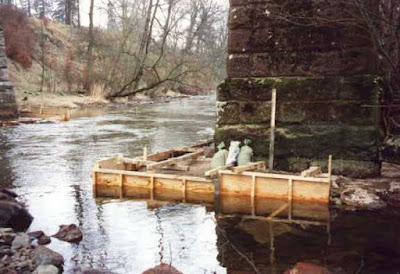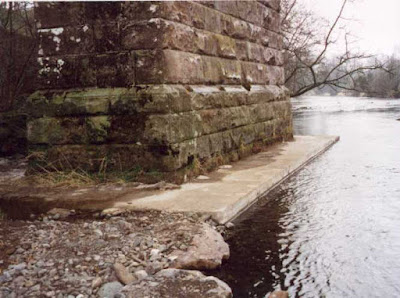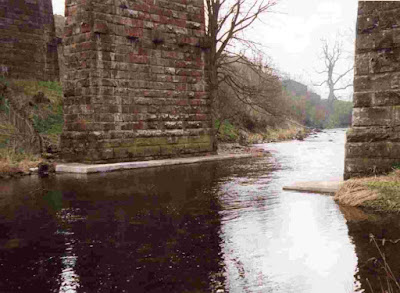The title is a top of the head idea.
The extrados is the outside surface of an arch and one of many uses of ancient languages in civil engineering.
RAILWAY STRUCTURES MAINTENANCE
No. 6 in an occasional series by Dave Haynes
Lancaster & Carlisle Line Bridge Number 169, River Eamont- Scour Protection WorksIn the early hours of Monday 19th October 1987, the Afon Tywi between Llandovery and Llandeilo, swollen by earlier rainfall, removed an excess of bed material from the base of the bridge carrying the Central Wales Line at Glanrhyd. The resulting pier collapse dragged down the steel deck that it carried. Tragically, this problem was not identified by British Rail staff until the next Sprinter plunged into the river drowning several passengers.
Up until the Glanrhyd failure, the accepted examining procedure was to carry out a special inspection of structures after heavy rain if scour was suspected. Scour however can occur suddenly, making post-flood examination pointless. Following the collapse, BR and Hydraulics Research carried out a comprehensive study that resulted in the production of Handbook 47, the manual for assessment of scour risk. Some 2200 railway bridges over water initially appeared vulnerable to scour. Handbook 47 considers various factors besides the bridge and immediate vicinity, such as river and landscape characteristics and therefore the number of bridges considered to be at risk was reduced to 350 following revised assessment. The nature of the assessment also prioritised risk, thus aiding the budgeting of scour protection works.

Figure 1 - Location plan
Bridge 169 carries the Lancaster and Carlisle Line over the River Eamont just south of Penrith, Figure 1. Following Glanrhyd, this bridge was assessed under Handbook 47 and was considered to be at risk from scour, justifying additional protection works.
The viaduct consist of six masonry arches, Figures 2, 3 and 4, of which only one is a permanent river channel.

Figure 2 - East
elevation
Figure 3 - West
elevation
Figure 4 - West
elevation of river channel
During flood events the ground beneath the adjacent arches is also flooded. In the past 20 years, various scour protection works had been carried out at the foot of the river channel piers. Primarily, a 750mm wide construction of concrete filled hessian bags had been constructed, topped with a concrete apron. Over time however, this apron itself had been scoured, leaving the base of the piers exposed to potential scour, Figure 5.
Figure 5 - North
pier prior to works
Even slight alterations to the river flow by civil engineering work could result in change in the hydraulics of the river, thus worsening scour potential. Furthermore, the Environment Agency had particular concern that a fish farm down stream from the works was not adversely affected by disturbance of sediment or contamination of the river by cementitious products.
Although not at risk from the actual works in the river, concern was expressed by one landowner adjacent to the bridge. Unlike farmers who constitute most neighbours of the railway, this gentleman farmer, and this term should be taken literally, to the north-east of the bridge, was a tree collector who travelled the world in search of specimens. Walking down from the ancestral pile to the river, he proudly pointed out his most recent specimen, which he had recently brought over from Chile. This arboretum next to Bridge 169 must represent one of the most unusual woods bordering the railway.
In order to satisfy the submission requirements for works in rivers, a scheme drawing was required that would illustrate the proposals include the existing and proposed river profile at the bridge. A physical survey of the river in the vicinity of the bridge was therefore carried out using a bank based survey instrument and dinghy and from this a drawing could be produced. The proposed works must be shown not to significantly change bed and bank profiles. An inflatable dinghy was used during the survey, Figure 6, and I didn't get wet either!
Figure 6 -
Survey using an inflatable dinghy
Initially a trench nominally 1.5m wide was
excavated around the remains of the aprons, returning half way
along the end faces of the piers to a depth of 1m below the level
of general scour. This empirical depth assumes that providing the
river regime is not altered, scour will not undermine the
finished works.
Figure 7 -
Section of protection works
Following this, loose
bagwork was removed from the dilapidated apron and where
the voids were large enough, they were filled with new
hessian bags containing 1:2:4 cement: sand: aggregate
mix.
It was anticipated that
hessian would retain the majority of the cement matrix
prior to curing. Where necessary, new sections of apron were built up from the solid base of the excavation in bagwork. Following reconstruction of the bagwork core, shuttering was constructed around the apron and all voids grouted with a Pozament PFA grout, Figure 8.
Figure 8 -
Shuttering around south pier
The completed works, Figures 9 &10, are a significant improvement on the scour protection previously provided as the new aprons are now fronted by armourstone blocks, set below the existing local scour level at the piers. Ongoing regular programmed bridge examinations and high water flow checks will ensure that the scour protection is not compromised. In addition to this, automatic scour monitoring devices such as sonar, radar, video and special sensors have been considered and will without doubt play an increasingly important role in the future.
Figure 9 - North
pier after works
Figure 10 - Finished
scour protection works
Afterword: I cannot remember why the ends of the concrete apron where not given streamlined profiles, my only thought is that it was probably due to the ever present financial constraints of a short budget cycle. Network Rail now have longer cycles which remove a lot of the short term financial moves seen so often in the past. But not all!







